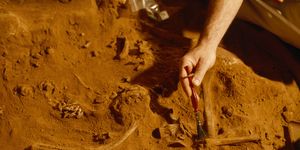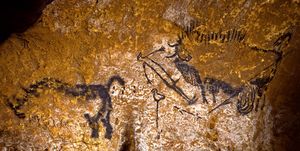The plot thickens in the saga of our evolution.
BY TIM NEWCOMB
PUBLISHED: MAY 22, 2024


Junatura//Getty Images
A reconstruction of an ancient Chinese skull may tie the Dragon Man lineage even closer to Homo sapiens.
Scientists have revealed potential ties between Denisovans, Dragon Man, and Yunxian Man lines.
Potential links between the archaic humans and Homo Sapiens are still a source of intrigue.
The exact ties between archaic human lines and Homo sapiens may remain unknown, but a recent effort to analyze ancient Chinese skulls potentially just brought those links closer together.
To better understand the growth of the Homo family—and specifically where H. sapiens fits into the history of the world—researchers have long studied other Homo lines. This research has led them to investigate lineages ranging from the relatively well-known Denisovans to lesser-known lines based on just a few found skulls, such as the Dragon Man and Yunxian Man lineages from China.

Proof of First Trek from Africa to Australia
With some of the found skulls potentially being 1 million years old, there isn’t exactly a wealth of data to go off, so a team of researchers reconstructed one of three Yunxian Man skulls from what is believed an unknown human species from the Yunyang District of Hubei province in Central China. The findings—published on the non-peer-reviewed pre-print server bioRxiv—claim that this ‘Yunxian 2’ skull just might be of the same lineage as the Dragon Man, and potentially one of the last common ancestors of H. sapiens
“It is very controversial whether these fossil humans represent different species or lineages,” the authors wrote in the study. “The 1-million-year-old Yunxian 2 fossil from China is crucial for understanding the cladogenesis of Homo and the origin of Homo sapiens.”
Using new technology, the team restored and reconstructed the cranium, and the results suggested that whoever this skull used to belong to was “an early member of the Asian ‘Dragon Man’ lineage, which probably includes the Denisovans, and is the sister group of the H. sapiens lineage.”
The team said that both the H. sapiens and Dragon Man lineages having deep roots extending beyond the Middle Pleistocene age, and the Yunxian fossil cranium “suggests it represents a population lying close to the last common ancestor of the two lineages.”
With some of the found skulls potentially being 1 million years old, there isn’t exactly a wealth of data to go off, so a team of researchers reconstructed one of three Yunxian Man skulls from what is believed an unknown human species from the Yunyang District of Hubei province in Central China. The findings—published on the non-peer-reviewed pre-print server bioRxiv—claim that this ‘Yunxian 2’ skull just might be of the same lineage as the Dragon Man, and potentially one of the last common ancestors of H. sapiens
“It is very controversial whether these fossil humans represent different species or lineages,” the authors wrote in the study. “The 1-million-year-old Yunxian 2 fossil from China is crucial for understanding the cladogenesis of Homo and the origin of Homo sapiens.”
Using new technology, the team restored and reconstructed the cranium, and the results suggested that whoever this skull used to belong to was “an early member of the Asian ‘Dragon Man’ lineage, which probably includes the Denisovans, and is the sister group of the H. sapiens lineage.”
The team said that both the H. sapiens and Dragon Man lineages having deep roots extending beyond the Middle Pleistocene age, and the Yunxian fossil cranium “suggests it represents a population lying close to the last common ancestor of the two lineages.”
Ancient Cave Paintings Held Astronomical Readings
Some researchers believe that the Homo lines eventually diverged. In that split, the Denisovans—which could have included both the Dragon Man and Yunxian Man lines—wenr extinct, while the H. sapiens line continued to evolve into modern humans. Those sister lines have a long history of interaction until they don’t, and finding that point of divergence has so far eluded scientists.
To complicate the effort beyond having so few fossils to work with, the Yunxian Man fossil is believed to be roughly 1 million years old—much older than either the Dragon Man or H. sapiens. Still, it could mean that Yunxian Man offers a common link, as an ancestor of sorts, between the Dragon Man and H. Sapiens.
“It is reasonable to conclude,” the authors wrote, “that Yunxian is morphologically and chronologically close to the last common ancestor of the lineages of H. sapiens and Dragon Man.”
Some researchers believe that the Homo lines eventually diverged. In that split, the Denisovans—which could have included both the Dragon Man and Yunxian Man lines—wenr extinct, while the H. sapiens line continued to evolve into modern humans. Those sister lines have a long history of interaction until they don’t, and finding that point of divergence has so far eluded scientists.
To complicate the effort beyond having so few fossils to work with, the Yunxian Man fossil is believed to be roughly 1 million years old—much older than either the Dragon Man or H. sapiens. Still, it could mean that Yunxian Man offers a common link, as an ancestor of sorts, between the Dragon Man and H. Sapiens.
“It is reasonable to conclude,” the authors wrote, “that Yunxian is morphologically and chronologically close to the last common ancestor of the lineages of H. sapiens and Dragon Man.”

No comments:
Post a Comment